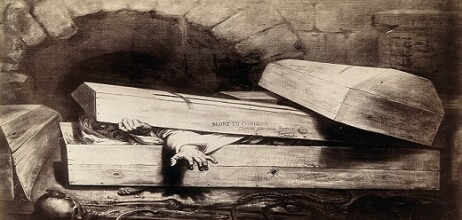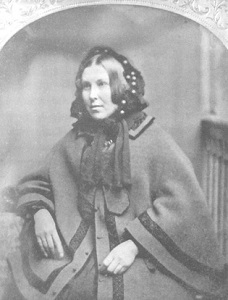Life under lockdown: the 1832 cholera epidemic as seen by Charlotte Stoker
Today Sligo, like all other towns and cities in Ireland, is largely shuttered and empty thanks to the government’s COVID-19 restrictions. The last time Sligo was deserted under similar circumstances was in 1832, when people were too terrified to leave their homes due to contagion. At that time a girl called Charlotte Thornley (1818-1901) then aged 14, was in lockdown with her family during the great cholera pandemic. Charlotte would go on to write Experiences of the cholera in Ireland (1873) an unpublished account currently held in the Special Collections Library of TCD.[1] This document is not only a valuable and credible first-hand historic account but some of the gruesome details clearly influenced the literary output of Charlotte’s son, the author Bram Stoker. On its own Experiences is worth analysing as a compelling description of the fear, panic and peoples’ reactions to a pandemic and life under lockdown, some of which will sound familiar to us today.
Cholera, a novel disease
Like COVID-19, 'Asiatic Cholera' was a disease new to Europe, rampant on the continent since 1831. In Experiences Charlotte described the wait for cholera to inevitably appear in their town as a “dread” as they heard “of the new and terrible plague which was desolating all lands as it passed through them.” People heard reports of how cholera offered an agonising and undignified death within hours. In an age where most scientists subscribed to miasmic theory people did not stand a chance against cholera. There was no cure and little effective treatment.
“It’s utter strangeness and man’s want of experience or knowledge of its nature, or how best to resist its attack, added if anything could to its horrors”- Stoker, Experiences.
By 1832, it was coming closer to home and Charlotte wrote “with wild affright we began to hear a whisper pass 'It was in Ireland'”. By August, cholera was in Sligo and took its first official victim on the 11th - the same date that Count Dracula took his first victim on English soil in Bram Stoker’s 1897 novel. Within six weeks, it is thought, the lives of up to 1500 people were claimed by the disease in the town. Sligo was declared the worst affected town in all of Ireland or Britain that year.
Lockdown during cholera
To middle class protestants like the Thornley family cholera had an added fear factor – it affected people in good health and wealth, and their privilege would not offer them the immunity to the various famines and fevers that had previously torn through the poorer population.
Cholera took its victims swiftly. Charlotte told of visiting their friends the Holmes family who consisted of three adults and eight children: “we left them all well at half past nine, and the next morning at 9 o’clock we heard that [six of the family] were dead and [had already been] buried.”
“In a very few days the town became like a city of the dead” - Stoker, Experiences.
The town became deserted, businesses shut, people stayed indoors with “no vehicles except the Cholera carts or Doctor carriages”. The protestant clergy largely fled the town and wakes were suspended. Riots were threatened. In Sligo the sounds of the cries of the bereaved women and children were audible in the streets.
As the outbreak intensified the Thornley’s ceased to leave their home. They had a cow and hens in their back yard which afforded them some self-sufficiency as there were food shortages in the town. Charlotte’s mother Matilda would leave jugs of milk out on the doorstep for her poorer neighbours. Other than this there was little contact with the outside world. Despite being asked not to, a salesman still knocked each morning on the Thornley’s door to ask if coffins were needed, a rudeness Charlotte described as “a climax hard to bear, few nerves could stand it”. Eventually she upended a jug of water on his head.

https://wellcomecollection.org/works/h94tevfb/images?id=cgj8g8b6

https://sligowalkingtours.com/charlotte-thornley-stoker/
Published: 20 May 2020 Categories: Covid-19 and the Humanities, English Literature, History

